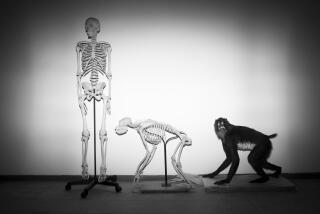Archosaur fossils found in Tanzania are forcing scientists to rethink the evolution of dinosaurs
- Share via
Scientists have identified one of the earliest known dinosaur relatives — and it doesn’t look anything like they expected.
Researchers had thought that the oldest dinosaur cousins would look rather like small, two-legged dinosaurs themselves. Instead, Teleocrater rhadinus actually stretched seven to 10 feet long, boasted a long neck and tail, and walked on all fours.
The findings, described in the journal Nature, could force paleontologists to redraw their understanding of dinosaurs’ origins, as well as the nature of the reptiles that came before them.
“This just goes to show that there’s a lot more out there that we just didn’t know, especially the early history of the larger group that dinosaurs belonged to: Archosauria,” said lead author Sterling Nesbitt, a vertebrate paleontologist at Virginia Tech in Blacksburg.
Dinosaurs are part of a larger group known as the archosaurs — a lineage of reptiles that split into a “bird-line” branch that includes pterosaurs, dinosaurs and birds, and a “crocodilian” branch whose living members today include crocodiles and alligators.
Paleontologists have long tried to predict what those early bird-line reptiles looked like, soon after the split with the crocodilian branch. But they haven’t been able to do so because of the large gaps in the fossil record of the transitional period before dinosaurs emerged in the mid-to-late Triassic Period, roughly 230 million years ago. Which dinosaur traits are unique to dinosaurs, and which are shared with these earlier archosaurs, they have wondered? Without a wide range of older archosaur fossils, it was difficult to say for sure.
Still, many figured that the line of animals that gave rise to the flying reptiles known as pterosaurs, and later the dinosaurs, which themselves gave rise to birds (the only surviving member of the bird-line branch) might have originally come from a chicken-sized, two-legged, dinosaur-like archosaur.
The Teleocrater fossils described by Nesbitt and his colleagues may be proving that idea wrong. This species isn’t exactly new to science: Paleontologist F. Rex Parrington first found fossils in Tanzania in 1933 and English paleontologist Alan J. Charig (a posthumous co-author of this paper) characterized the bones roughly two decades later. But the first specimen was missing crucial bones that would have allowed Charig to tell whether this was a bird-branch or crocodile-branch species of archosaur.
To help fill in those key missing details, Nesbitt and his colleagues studied the original specimen together with three new partial Teleocrater specimens, discovered in 2015 not far from where those original fossils were found. Researchers usually look for certain physical features on the skeleton that remain preserved in a lineage even as species differentiate over time. In the case of Teleocrater, it had a number of markers that identified it as a bird-lineage archosaur, such as a telltale depression on top of the head. It also had a muscle scar high on the thigh bone — a characteristic you see even in chicken legs today. (In crocodilians and in lizards, the muscles are more evenly distributed across the leg.)
But even as Nesbitt and his colleagues identified Teleocrater as a bird-like archosaur, they also found surprisingly crocodilian characteristics, including the animal’s ankle bones. In fact, the entire body plan, with its long, low, four-legged profile, seems in some ways more reminiscent of crocodiles than of theropods, a group of dinosaurs that includes Tyrannosaurus rex and also gave rise to the birds we know today.
“The ankle was really a big surprise with this animal, because all of the archosaurs on the bird side of the tree [including] dinosaurs all have what we call a bird-like ankle, which has a pretty simple hinge, and all the archosaurs on the croc side of the tree have what we call a ‘crocodile normal’ ankle or a crocodile-like ankle,” Nesbitt said. “That tells us that the crocodile ankle was primitive for the earliest archosaurs and that the bird ankle was derived from a crocodile-like ankle.”
This is strange, because that high-thigh muscle scar found in bird-branch archosaurs is typical of animals that walk on two legs — not animals like Teleocrater, which appeared to walk on all fours.
So what explains this weird muscle configuration? For now, it’s unclear, said Nesbitt, who pointed out that many physical features evolved for one purpose before being conscripted into other duties. Feathers, for example, were probably used for insulation, camouflage and even mating displays long before they were repurposed for flight.
“It’s something we see commonly in vertebrate or just animal history,” Nesbitt said.
In any case, that ancient shared ancestor of both crocodiles and dinosaurs (and birds) may have looked more like the former than the latter. And this could change our understanding of which features were originally from early archosaurs, and which emerged much later. It may also cause scientists to reevaluate which ancient archosaurs they study to try to understand what a dinosaur ancestor might have looked like.
The findings, together with other recent discoveries, also highlight how diverse and successful a group the nondinosaur archosaurs were, even if they have fewer representatives among our current fossil records.
“People have concentrated on dinosaurs for a really long time; they were really successful for almost 180 million years and they continue on as successful birds today,” Nesbitt said. “But in the Triassic, they were just a small component of this big radiation of the relatives of dinosaurs.”
Nesbitt and his colleagues plan to return to Tanzania in May to try to fill in more gaps in left in their partial skeletons, and more gaps in our understanding of these long-gone species.
Follow @aminawrite on Twitter for more science news and “like” Los Angeles Times Science & Health on Facebook.
MORE IN SCIENCE
New view of dinosaurs could radically reshape their family tree
Your fitness tracker can count your steps, but it’s not that good at monitoring your heart rate







